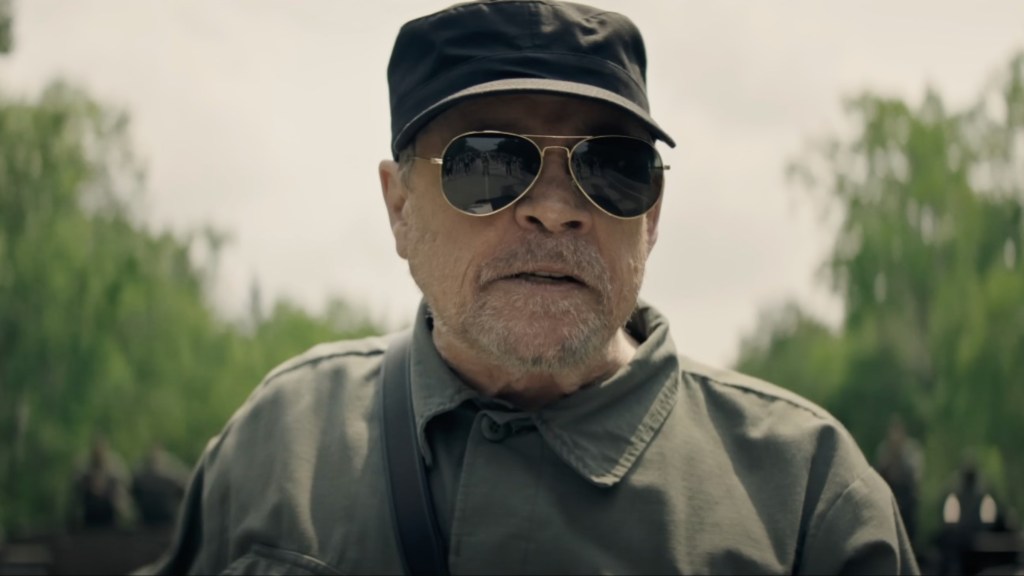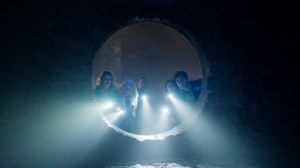The best Stephen King adaptations don’t necessarily just rip the pages out of the book and feed them into a camera. Adaptations, by their definition, require changes, but some filmmakers are freer with the process than others.
Videos by ComicBook.com
The main changes you’ll see in Stephen King movies are the endings. The author is so well-known for leaving things open and unresolved that even his cameo character in It: Chapter Two mentions it to the movie’s King analogue. Some of these movies ignore the original, unclear endings in favor of something more definitive; others completely ditch the themes, mood, or even the entire plot of the written work (see: The Lawnmower Man).
These projects all took key points of their source material and said, “Actually, what if we didn’t do that at all?”
10) The Night Flier

The Night Flier features sleazy tabloid reporter Richard Dees (Miguel Ferrer), whose latest story has him looking into a string of murders at remote airports. His investigation leads him to Dwight Renfield, a vampire with a pilot’s license.
The movie pretty closely follows the story until the ending, which has Dees finally meeting Renfield just after one of his feasts. Renfield forces Dees to drink his blood, which makes him think the bodies around him have come to life. He starts hacking them with an axe, and the arriving police shoot him to death. His colleague’s ensuing story blames Dees for all of the murders.
The original story just has Renfield destroying Dees’ evidence, leaving him haunted and having to deal with the police. It’s a small change, but it makes more sense to make Dees live with some of the trauma his work has inflicted upon others.
9) 1408

Both the original story and film adaptation of 1408 are about a haunted (or cursed?) hotel room in the middle of New York City, but they have different takes on the nature of the evil.
In the story, Mike Enslin, a writer of books about haunted places, spends about 70 minutes in the room, experiencing surreal but generalized phenomena. Eventually, he gets the sense that an entity of some kind is about to come through one of the room’s walls, and he’s barely able to escape.
The movie has Room 1408 create a bespoke haunting experience for Mike based on his memories, and the plan is to put him through the same hour until he “checks out.” The film version is more inexplicable; it’s just a bad place that wants you to die instead of an eldritch horror’s elusive food bowl. We’re fine with both, but they’re very different.
7) The Raft

“The Raft” is a segment from the anthology film Creepshow 2. Both it and the original story are about a group of teens who swim out to a raft on a lake and then fall victim to a carnivorous goop floating on the water.
The end of the story has the final survivor, Randy, staring into the creature’s hypnotic, shimmering colors and wondering if it will hurt when the thing eats him. The film adaptation, however, has Randy making a break for the shore while the monster is eating one of his friends. And he makes it … until his pursuer rears up like a wave and pulls him into the lake. The segment ends with the camera panning over to a hidden “No Swimming” sign, which is a solid gag.
6) The Mist (2007)

This tale of people hiding in a supermarket when a scary fog full of monsters follows the original novella pretty closely – but once again, the filmmakers made huge changes to the ending. The story ends with the survivors of the transdimensional invasion of nightmare creatures driving into the unknown, unsure where the road will lead them. The movie decides to ruin everyone’s day.
At the conclusion of the film, the survivors, all packed into a car, run out of gas and sit there listening to what they assume are horrific monsters coming to eat them. David (Thomas Jane), making what he thinks is the humane decision, uses the last of his ammunition to kill everyone quickly, including his own son. He leaves the car to accept his fate, which is when we learn that the noises the group heard were from military vehicles clearing the mist and dispatching the monsters. Is this a better ending? Yes. But it’s also terrible.
5) The Long Walk

The Long Walk is a faithful adaptation of King’s novel of the same name, which has a group of boys walking nonstop down a highway until only one is left; the “winner” gets a prize (in the book, whatever they want forever; in the movie, money and a single wish). Once again, however, filmmakers had some notes about the ending.
The book ends with the winner of the Walk, Ray Garraty, completely snapping from reality and continuing to walk – even run – toward a shadowy figure only he can see. It’s kind of a downer. The movie ends with a different winner, Peter McVries (David Jonsson), using his own Prize wish to honor Garraty’s desire to kill the Major (Mark Hamill), who oversees the Walk. Like in the book, Peter does just keep on going after that, but the extra touch delivers some much-needed closure to the story.
4) The Running Man (1987)

The original Running Man novel has the contestants of the eponymous, extreme reality show fleeing for their lives across the world. The scale is huge, and the game runs for up to 30 days. Protagonist Ben Richards dons disguises, goes to other cities, and has numerous run-ins with the police and everyday people along with the people hunting him.
The 1987 film adaptation ignores most of that and scales it way down. The show’s Hunters track the contestants through a dilapidated section of Los Angeles, and everything takes place in the course of one night. The novel’s scrawny Ben also becomes the movie’s decidedly un-scrawny Arnold Schwarzenegger. The story changes make for a tighter, more contained story, and the casting pushed the movie into a wisecracking action romp that abandons the novel’s darker themes and nihilism.
8) The Boogeyman

2023’s The Boogeyman shares a character’s name and history with the original work … and that’s it.
Typically, expanding a short story into a movie is going to require you to draw some things out; we get that. In the original, Lester Billings tells his psychiatrist, Dr. Harper, about the deaths of his young children, who all passed while seemingly alone in their rooms. They all said “Boogeyman” before they died, and Lester found their closets open. At the end, he discovers Harper has been the Boogeyman the whole time.
The movie starts with Lester, but then he “passes” the Boogeyman curse on to Harper’s house. As it turns out, the Boogeyman is a Grief Monster like the Babadook, and it’s found a new troubled home. The movie essentially takes everything scary about the story and stretches it into a feature-length metaphor.
3) Doctor Sleep

Writer and director Mike Flanagan had a tough decision to make when he adapted this sequel. Which project was he following up on, the original novel or its film version? He basically decided to do both.
While the general plot of Doctor Sleep matches the book – a grown-up Danny Torrance meets a child with the “shine” and helps her defeat a gang of psychic vampires – it’s pretty clear that it’s more of a sequel to the 1980 film. The Overlook Hotel is still standing, Dick Hallorann is a ghost, and this movie’s versions of Danny’s parents look just like movie actors Shelley Duvall and Jack Nicholson.
Flanagan does throw King a bone by giving Danny the same fate as his father in the novel: He overloads the Overlook’s boiler, sacrificing himself to save his friend. But the rest of the movie looks and feels more like Kubrick’s work than King’s.
2) The Shining

Director Stanley Kubrick’s adaptation of King’s novel is one of the most beloved horror films of all time, but you’d never know that if you’ve ever heard the author talk about it. He is not a fan.
The premise is the same, sure. The Torrances – Jack, Wendy, and young Danny – go out to the Overlook Hotel to watch it for the winter season. Danny is vaguely psychic; some ghosts appear, and madness ensues. But the movie downplays the supernatural elements in favor of a more human antagonist. It also repositions the threat as coming from inside (Jack’s alcoholism and anger) rather than the novel’s external sources (the extremely haunted hotel and its very real ghosts).
We’re not about to take sides on the King vs. Kubrick conflict, but we do think Kubrick’s version is leagues better than the made-for-TV remake.
1) The Monkey

Writer and director Osgood Perkins took Stephen King’s eerie story about a toy monkey whose cymbals portend death and turned it into a gruesome comedy. He also changed the cymbals to a drum, but the first change is more significant.
The Monkey may be the Stephen King adaptation that least resembles its source material, which is not a slight against either version of the story. King’s version is packed with dread, and Perkins’ is a hilarious examination of the frequent randomness of life (and death). Where other “grief horror” films are morose, introspective affairs, it’s a pitch-black comedy that’s as funny as it is violent.
You can stream all of these films on various platforms. Want to stay up to date on the biggest geek entertainment news? Add us as a preferred source in Google – HERE, and join our community over on the ComicBook Forum for deeper takes and discussions!








